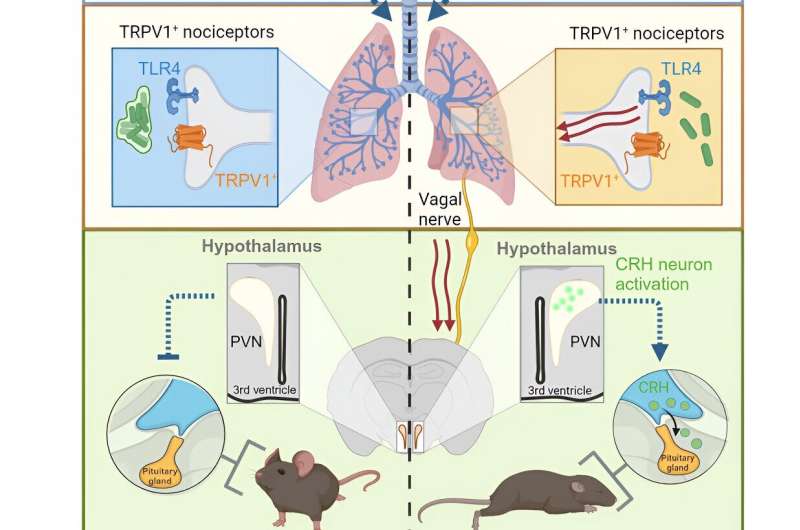This article has been reviewed according to Science X's editorial process and policies. Editors have highlighted the following attributes while ensuring the content's credibility:
fact-checked
peer-reviewed publication
trusted source
proofread
New research finds a direct communication path between the lungs and the brain

University of Calgary researchers have discovered the lungs communicate directly with the brain when there is an infection. Findings show that the brain plays a critical role in triggering the symptoms of sickness, which may change the way we treat respiratory infections and chronic conditions.
The work is published in the journal Cell.
"The lungs are using the same sensors and neurons in the pain pathway to let the brain know there's an infection," says Dr. Bryan Yipp, MD, clinician researcher at the Cumming School of Medicine and senior author on the study. "The brain prompts the symptoms associated with sickness; that overall feeling of being unwell, feeling tired and losing your appetite. The discovery indicates we may have to treat the nervous system as well as the infection."
Prior to this study, conducted in mice, it was thought infections in the lungs and pneumonia induce inflammatory molecules that eventually made their way to the brain through the bloodstream. Sickness was thought to be a consequence of the immune system kicking into action. However, findings reveal that sickness results from nervous system activation in the lung.
Understanding the lung-brain dialogue is important for treatment because bacteria that cause lung infections can produce a biofilm, a coating to surround themselves so the nervous system can't see them. That allows the bug to hide out in the lungs for a long time, which may shed light across diverse serious lung infections that are less symptomatic. For example, an unexplained anomaly Yipp witnessed in the intensive care unit (ICU) during COVID. The phenomenon, coined "happy hypoxia," was being recorded in ICUs throughout the world.
"We would have patients whose oxygen levels were extremely low and X-rays confirmed they may need to be put on life support. Yet, when I went to see the patient, they would say I feel fine," says Yipp. "These people were experiencing limited sickness symptoms even though the virus was aggressively damaging their lungs."
Yipp says understanding the lung brain communication pathways may also have broad implications for people with chronic lung infections like cystic fibrosis (CF). Many people with CF have a biofilm bacterium in their lungs and are asymptomatic. They feel okay, but then have a flare where they can become very ill. The reason for the flare can't always be traced.
"It is possible the flare is also neurological that these people live asymptomatically because bacteria are hiding out," says Yipp.
The findings are the work of an interdisciplinary team including experts in neurobiology, microbiology, immunology, and infectious disease.
"Physician specialties are usually based on individual organs, with pulmonologists caring for the lungs and neurologists caring for the brain. Our study shows the lung is altering the brain and the brain is altering the organ. This intersection of communication is a different way of thinking about disease," says Yipp. "It's all connected to the brain and there are probably even more complex circuits that are happening. We can now think about targeting neurocircuitry along with antibiotics to deal with infections and the sickness they cause."
University of Calgary researchers Drs. Christophe Altier, Ph.D., Joe Harrison, Ph.D., and Deborah Kurrasch, Ph.D., along with Dr. Jaideep Bains, Ph.D., Krembil Research Institute, Toronto, are corresponding authors on the study.
The researchers add there was one more unique finding. Male mice were much sicker than the females even though they had the same bacterial infection. Researchers found that male sickness was more dependent on neuronal communications then females. Yipp says this finding could lend credibility to the so-called "man flu," a colloquial term where men are thought to wildly exaggerate sickness due to respiratory infections. They may not be exaggerating, after all.
More information: Elise Granton et al, Biofilm exopolysaccharides alter sensory-neuron-mediated sickness during lung infection, Cell (2024). DOI: 10.1016/j.cell.2024.03.001




















